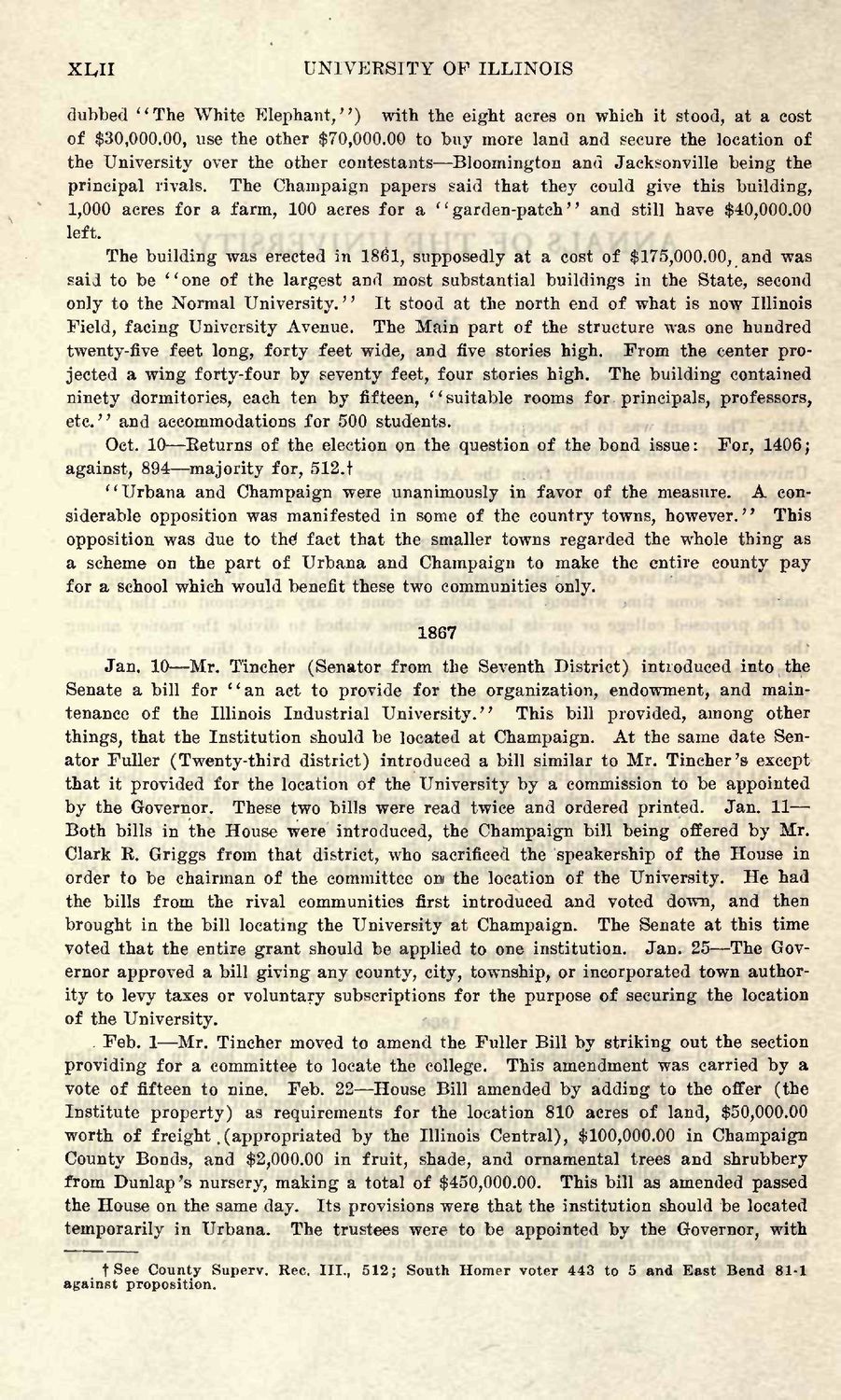| |
| |
Caption: Book - Early History of University (1916)
This is a reduced-resolution page image for fast online browsing.

EXTRACTED TEXT FROM PAGE:
XL,II U N I V E R S I T Y OP I L L I N O I S dubbed " T h e White E l e p h a n t , " ) with the eight acres on which it stood, at a cost of $30,000.00, use the other $70,000.00 to buy more land and secure the location of the University over the other contestants—Bloomington and Jacksonville being the principal rivals. The Champaign papers said that they could give this building, 1,000 acres for a farm, 100 acres for a " g a r d e n - p a t c h " and still have $40,000.00 left. The building was erected in 1861, supposedly at a cost of $175,000.00, and was said to be " one of the largest and most substantial buildings in the State, second only to the Normal University." I t stood at the north end of what is now Illinois Field, facing University Avenue. The Main part of the structure was one hundred twenty-five feet long, forty feet wide, and five stories high. From the center projected a wing forty-four by seventy feet, four stories high. The building contained ninety dormitories, each ten by fifteen, " s u i t a b l e rooms for principals, professors, e t c . " and accommodations for 500 students. Oct. 10—Eeturns of the election on the question of the bond issue: For, 1406; against, 894—majority for, 512.t " U r b a n a and Champaign were unanimously in favor of the measure. A considerable opposition was manifested in some of the country towns, however." This opposition was due to the1 fact that the smaller towns regarded the whole thing as a scheme on the part of Urbana and Champaign to make the entire county pay for a school which would benefit these two communities only. 1867 Jan. 10—Mr. Tincher (Senator from the Seventh District) introduced into the Senate a bill for ' ' an act to provide for the organization, endowment, and maintenance of the Illinois Industrial University." This bill provided, among other things, that the Institution should be located at Champaign. At the same date Senator Fuller (Twenty-third district) introduced a bill similar to Mr. Tincher's except that it provided for the location of the University by a commission to be appointed by the Governor. These two bills were read twice and ordered printed. J a n . 1 1 — Both bills in the House were introduced, the Champaign bill being offered by Mr. Clark E. Griggs from that district, who sacrificed the speakership of the House in order to be chairman of the committee oni the location of the University. H e had the bills from the rival communities first introduced and voted down, and then brought in the bill locating the University at Champaign. The Senate at this time voted that the entire grant should be applied to one institution. J a n . 25—The Governor approved a bill giving any county, city, township, or incorporated town authority to levy taxes or voluntary subscriptions for the purpose of securing the location of the University. . Feb. 1—Mr. Tincher moved to amend the Fuller Bill by striking out the section providing for a committee to locate the college. This amendment was carried by a vote of fifteen to nine. Feb. 22—House Bill amended by adding to the offer (the Institute property) as requirements for the location 810 acres of land, $50,000.00 worth of freight.(appropriated by the Illinois Central), $100,000.00 in Champaign County Bonds, and $2,000.00 in fruit, shade, and ornamental trees and shrubbery from Dunlap's nursery, making a total of $450,000.00. This bill as amended passed the House on the same day. Its provisions were that the institution should be located temporarily in Urbana. The trustees were to be appointed by the Governor, with t See County Superv. Rec. III., 512; South Homer voter 443 to 5 and East Bend 81-1 against proposition.
| |